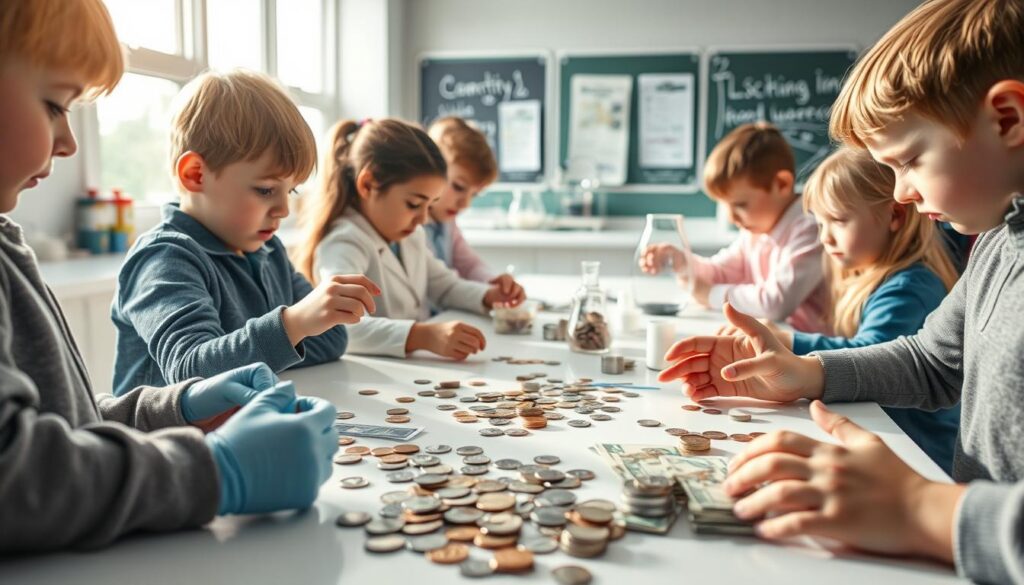Hey there, fellow young scientists! I’m Zara, and I’m 12 years old just like some of you reading this. I own a website called Assetsforkids because I love helping kids learn about finance in fun ways.
Today, I want to share something amazing with you. We can mix STEM learning activities with learning about money! It’s not just about math or sitting in class.
We’re talking about real experiments you can do with coins, bills, and everyday stuff. These money education experiments will amaze you and teach you about finance.
Whether you’re 7 or 14, these projects will teach you about financial literacy for kids while you have fun. Trust me, once you try mixing currency with experiments, you’ll see your allowance in a whole new light!
Why I Love Mixing Money and Science
Blending money and science is magical. Money and science are all around us. Every time you shop, you use math and science without realizing it.
When you save your money, you’re doing a long-term experiment. I learned this by doing simple coin experiments at home. Did you know that different coins are made of different metals? You can even test what’s inside a penny with lemon juice.
It’s like being a detective, solving money mysteries. These educational science projects teach you real-life skills. They help you make smarter choices about money.

Plus, your parents and teachers will be impressed. You can explain financial concepts using science. It makes learning fun, not boring.
Instead of just reading about money, you can test it in fun ways. This method helps you understand money better through hands-on learning. You can also add pocket money puzzles and math games to make it more exciting.
The best part? You probably already have most of the materials you need right at home! You can do cool science experiments with spare change and household items. This makes educational science projects fun for everyone.
Super Easy Money Science Projects to Start With
Let me share my favorite beginner science experiments that make learning about money super fun and easy. I always start kids off with the Amazing Penny Test. It’s simple, safe, and teaches a lot about coins.
This experiment works great for kids aged 7 to 14. You’ll discover how different pennies react to acid. You’ll also learn why some coins are worth more than others.
What You’ll Learn About Coin Value
The penny test shows you something amazing about coin composition. Pennies made before 1982 contain real copper. Newer ones are mostly zinc with copper coating.
When you test different pennies, you’ll see how the older copper ones react differently to lemon juice. This teaches you that coins have changed over time. Some materials are more valuable than others.

- 10 pennies from different years (some before 1982, some after)
- Fresh lemon juice or white vinegar
- Small clear glasses or bowls
- Needle-nose pliers (ask an adult to help)
- Paper towels for cleanup
Step-by-Step Instructions
First, sort your pennies by date. Put the older ones (before 1982) in one group and newer ones in another.
Next, pour lemon juice into two glasses. Drop the older pennies in one glass and newer pennies in the other. Watch what happens over the next hour!
The older copper pennies will turn bright and shiny. The newer zinc pennies might bubble or react differently. This shows you the difference in metals.
How This Teaches Saving
These simple money projects teach kids that not all money is the same. Some coins contain more valuable materials than others.
When you see how copper pennies clean up so nicely, you learn that taking care of your money matters. Clean, well-kept coins and bills last longer and look more valuable.
This experiment also shows why people collect older coins. The copper content makes pre-1982 pennies worth slightly more than face value to collectors.
Kids Learning About Money Through Science Fair Projects That Will Wow Everyone
Let me share my favorite advanced money experiments that always get the judges excited at school fairs. These projects teach real financial skills and look great on your display board.
I love these experiments because they show how money works in the real world. You’ll learn about investments, business decisions, and data tracking. Plus, your friends will think you’re a genius!
Setting Up Your Money Garden Experiment
This project is my absolute favorite because it’s like planting seeds but with money instead. You’ll need three clear jars and some play money or real coins if your parents say it’s okay.
Label your jars “Spending,” “Saving,” and “Investing.” Each week, put the same amount in each jar. The spending jar stays the same, but here’s the cool part. The saving jar grows by the amount you add, and the investing jar grows by what you add plus extra money to show how investments work.
This is where your investment simulation gets really exciting. Every week, add 10% more to your investing jar to show how real investments can grow over time.
Keep a chart showing how each jar changes. After a month, you’ll see amazing differences. The investing jar will have way more money than the others. This teaches you why grown-ups talk about investing for the future.
Testing Different Prices Like a Real Business
Now let’s add some business concepts for kids to your project. Set up a pretend lemonade stand with different prices. Test selling cups for 50 cents, $1, and $1.50.
Ask family members which price they’d pay. Count how many people choose each price. This shows you how businesses decide what to charge for their products.
Recording and Understanding Your Data
The best part about these experiments is tracking your results. Make colorful charts showing how your money jars grew each week. Create graphs showing which lemonade prices people liked best.
Write down what surprised you most. Did the investing jar grow faster than you expected? Were people willing to pay more for lemonade than you thought? These discoveries make your project stand out from other science fair entries.
Your display board should show all your charts, photos of your money jars, and your biggest discoveries. Judges love projects that teach real-life skills while being fun to do!
How to Show Off Your Money Science Project at School
After all your hard work, it’s time to show off at your science fair presentation! I’ve done this before and learned cool tricks. Your presentation will surely impress.
The secret to amazing student presentations is to grab attention. People love colorful displays and interesting facts. Here are my top tips!
Creating Charts That Tell Your Story
Charts are my go-to for project display ideas. I make colorful graphs that show my results clearly. Here’s what works best:
- Use bright colors like red, blue, and green
- Make your numbers big enough for people to read from far away
- Add simple titles that explain what each chart shows
- Include pictures of coins or dollar bills to make it fun
Bar charts are great for comparing money amounts. Line graphs show how savings grow over time.
Adding Cool Money Facts
I always include fun money facts that make people say “Wow!” These facts grab attention and show you learned something amazing. Try adding facts like how much a penny weighs or which president is on each coin.
Write your facts on colorful cards. Place them around your display board so people can read them while looking at your project.
Practice Your Money Vocabulary
Using the right money words makes you sound like an expert. Practice saying words like “interest,” “savings,” “budget,” and “investment” out loud. When judges hear you use these words correctly, they know you really understand money!
I write my key vocabulary words on note cards. This helps me remember them during my science fair presentation.
Share Your Amazing Results
This is the most exciting part! Tell everyone what you discovered about money. Did you learn how compound interest works? Did you figure out the best way to save allowance money?
Share your results with confidence. Smile when you talk about your project. Remember, you worked hard and learned important things about money that will help you forever!
Conclusion
I hope these science fair project ideas made you curious about money and science. You learn a lot from these experiments. They help you think critically and solve problems.
These projects show how STEM learning is fun when we connect it to things kids like. You learn math, chemistry, and economics in a fun way. You get to see and touch what you’re learning.
These projects teach you to think before you act. You become better at handling money. You start to see how money works in the world.
Choose a project that you really like and start it. You can begin with something simple or try something more challenging. Share what you learn with others and ask them questions.
Even after the science fair, your learning journey doesn’t stop. Use the scientific method in your everyday life. This helps you make smart choices, whether it’s about spending money or planning big purchases.
FAQ
What age groups are these money science projects perfect for?
These projects are great for kids aged 7 to 14. Younger kids can do simpler experiments with help. Older kids can do more advanced ones on their own.
The penny test is perfect for beginners. Testing different currencies is better for those who want a challenge.
Do I need expensive materials to do these money science fair projects?
No, you don’t need expensive materials. You probably have most of what you need at home. For the Amazing Penny Test, you need coins, lemon juice, and basic items.
These experiments use everyday materials to teach about money. You might need coins from your parents, but that’s about it!
How do these science projects actually teach kids about money management?
These experiments make money concepts real and easy to understand. Watching your money garden grow teaches about compound interest and saving.
Testing why items have different prices teaches about market forces. It’s more effective than just reading about money.
Can these projects really impress judges at school science fairs?
Yes, they can! These projects combine STEM education with practical life skills. Judges love seeing kids apply science to real-world topics like personal finance.
You can explain complex concepts like investment strategies and currency properties with actual data.
How long do these money science experiments typically take?
It varies. Simple experiments like testing coin properties can take an afternoon. But projects like the savings growth experiment or money garden take weeks to show results.
Start early so you have time to collect data and see changes over time.
What’s the best way to present these projects at school?
Tell a story with your data! Show before and after results and explain what surprised you. Connect your findings to real-life money decisions.
Bring examples, like showing how different coins react to tests. Or display charts that show how small amounts can grow through saving.
Are these experiments safe for kids to do at home?
Yes, when done properly! All the experiments use safe, household materials. But have an adult nearby, like when using lemon juice for coin testing.
Follow proper scientific safety procedures and never put coins or materials in your mouth.
How do these projects help with understanding financial literacy concepts?
These experiments make financial education concepts concrete and memorable. Instead of just hearing about budgeting or saving, you actually do experiments that show these principles.
Seeing how your “investments” grow or shrink based on different variables helps you understand risk and reward.